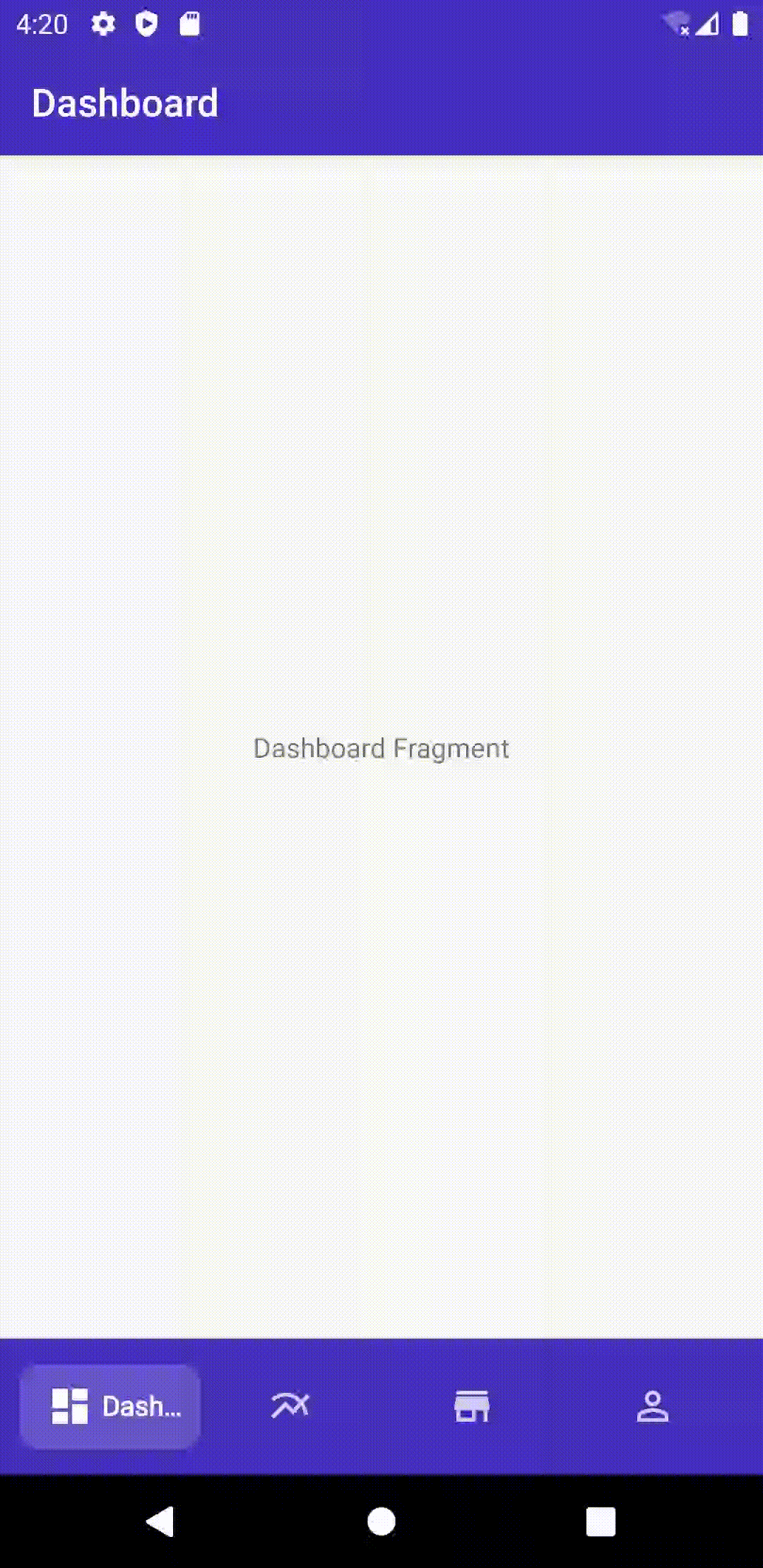A lightweight Android material bottom navigation bar library
- Create menu.xml under your res/menu/ folder
<?xml version="1.0" encoding="utf-8"?>
<menu xmlns:android="http://schemas.android.com/apk/res/android">
<item
android:id="@+id/item0"
android:title="@string/menu_dashboard"
android:icon="@drawable/ic_dashboard_white_24dp"/>
<item
android:id="@+id/item1"
android:title="@string/menu_leaderboard"
android:icon="@drawable/ic_multiline_chart_white_24dp"/>
<item
android:id="@+id/item2"
android:title="@string/menu_store"
android:icon="@drawable/ic_store_white_24dp"/>
<item
android:id="@+id/item3"
android:title="@string/menu_profile"
android:icon="@drawable/ic_person_outline_white_24dp"/>
</menu>- Add view into your layout file
<me.gozirin.TransparentBottomBar
android:id="@+id/bottomBar"
android:layout_width="match_parent"
android:layout_height="70dp"
app:backgroundColor="@color/colorPrimary"
app:badgeColor="@color/colorBadge"
app:menu="@menu/menu_bottom"/>- Use SmoothBottomBar callbacks in your activity
bottomBar.onItemSelected = {
status.text = "Item $it selected"
}
bottomBar.onItemReselected = {
status.text = "Item $it re-selected"
}OR
bottomBar.setOnItemSelectedListener(object: OnItemSelectedListener {
override fun onItemSelect(pos: Int) {
status.text = "Item $pos selected"
}
})
bottomBar.setOnItemReselectedListener(object: OnItemReselectedListener {
override fun onItemReselect(pos: Int) {
status.text = "Item $pos re-selected"
}
})Note: For projects without kotlin, you may need to add
org.jetbrains.kotlin:kotlin-stdlib:$kotlinVersionto your dependencies since this is a Kotlin library.
Use SmoothBottomBar with Navigation Components.
Coupled with the Navigation Component from the Android Jetpack, SmoothBottomBar offers easier navigation within your application by designating navigation to the Navigation Component. This works best when using fragments, as the Navigation component helps to handle your fragment transactions.
- Setup Navigation Component i.e. Add dependenccy to your project, create a Navigation Graph etc.
- For each Fragment in your Navigation Graph, ensure that the Fragment's
idis the same as the MenuItems in your Menu i.e res/menu/ folder
<?xml version="1.0" encoding="utf-8"?>
<menu xmlns:android="http://schemas.android.com/apk/res/android">
<item
android:id="@+id/first_fragment"
android:title="@string/menu_dashboard"
android:icon="@drawable/ic_dashboard_white_24dp"/>
<item
android:id="@+id/second_fragment"
android:title="@string/menu_leaderboard"
android:icon="@drawable/ic_multiline_chart_white_24dp"/>
<item
android:id="@+id/third_fragment"
android:title="@string/menu_store"
android:icon="@drawable/ic_store_white_24dp"/>
<item
android:id="@+id/fourth_fragment"
android:title="@string/menu_profile"
android:icon="@drawable/ic_person_outline_white_24dp"/>
</menu>Navigation Graph i.e res/navigation/ folder
<?xml version="1.0" encoding="utf-8"?>
<navigation xmlns:android="http://schemas.android.com/apk/res/android"
xmlns:app="http://schemas.android.com/apk/res-auto"
xmlns:tools="http://schemas.android.com/tools"
android:id="@+id/nav_graph"
app:startDestination="@id/first_fragment">
<fragment
android:id="@+id/first_fragment"
android:name="me.ibrahimsn.smoothbottombar.FirstFragment"
android:label="Dashboard"
tools:layout="@layout/fragment_first" >
<action
android:id="@+id/action_firstFragment_to_secondFragment"
app:destination="@id/second_fragment" />
</fragment>
<fragment
android:id="@+id/second_fragment"
android:name="me.ibrahimsn.smoothbottombar.SecondFragment"
android:label="Leaderboard"
tools:layout="@layout/fragment_second" >
<action
android:id="@+id/action_secondFragment_to_thirdFragment"
app:destination="@id/third_fragment" />
</fragment>
<fragment
android:id="@+id/third_fragment"
android:name="me.ibrahimsn.smoothbottombar.ThirdFragment"
android:label="Store"
tools:layout="@layout/fragment_third" >
<action
android:id="@+id/action_thirdFragment_to_fourthFragment"
app:destination="@id/fourth_fragment" />
</fragment>
<fragment
android:id="@+id/fourth_fragment"
android:name="me.ibrahimsn.smoothbottombar.FourthFragment"
android:label="Profile"
tools:layout="@layout/fragment_fourth" />
</navigation>- In your activity i.e
MainActivity, create an instance ofPopupMenuwhich takes acontextand ananchor(pass in null) and then inflate thisPopupMenuwith the layout menu for theSmoothBottomBar. - Get a reference to your
SmoothBottomBarand callsetupWithNavController()which takes in aMenuandNavController, pass in the menu of the previously instantiatedPopupMenui.e.(popUpMenu.menu) and yourNavController. - Preferably set this up in a function as shown below and call this function i.e. (
setupSmoothBottomMenu()) in theonCreatemethod of your activity.
N.B: Sample app makes use of ViewBinding to get reference to views in the layout.
private fun setupSmoothBottomMenu() {
binding.bottomBar.setupWithNavController(navController)
}You can also setup your ActionBar with the Navigation Component by calling setupActionBarWithNavController and pass in your NavController.
N.B: Your app needs to have a Toolbar for setupActionBarWithNavController to work. If your app theme doesn't have a Toolbar i.e. (Theme.AppCompat.Light.NoActionBar) you would need to:
- Add one to your layout i.e.
<com.google.android.material.appbar.AppBarLayout
android:id="@+id/app_bar_layout"
android:layout_width="match_parent"
android:layout_height="wrap_content"
app:layout_constraintEnd_toEndOf="parent"
app:layout_constraintStart_toStartOf="parent"
app:layout_constraintTop_toTopOf="parent">
<androidx.appcompat.widget.Toolbar
android:id="@+id/toolBar"
android:layout_width="match_parent"
android:layout_height="wrap_content" />
</com.google.android.material.appbar.AppBarLayout>- Set the support action bar to your
ToolbarusingsetSupportActionBar(your_toolbar_id)in this casesetSupportActionBar(binding.toolBar)
We now have something like this:
private lateinit var navController: NavController
private lateinit var binding: ActivityMainBinding
override fun onCreate(savedInstanceState: Bundle?) {
super.onCreate(savedInstanceState)
binding = ActivityMainBinding.inflate(layoutInflater)
setContentView(binding.root)
navController = findNavController(R.id.main_fragment)
setupActionBarWithNavController(navController)
setupSmoothBottomMenu()
}
private fun setupSmoothBottomMenu() {
binding.bottomBar.setupWithNavController(navController)
}
//set an active fragment programmatically
fun setSelectedItem(pos:Int){
binding.bottomBar.setSelectedItem(pos)
}
//set badge indicator
fun setBadge(pos:Int){
binding.bottomBar.setBadge(pos)
}
//remove badge indicator
fun removeBadge(pos:Int){
binding.bottomBar.removeBadge(pos)
}
override fun onSupportNavigateUp(): Boolean {
return navController.navigateUp() || super.onSupportNavigateUp()
}- Create the menu item you want to inflate in the
Toolbari.e.
<?xml version="1.0" encoding="utf-8"?>
<menu xmlns:android="http://schemas.android.com/apk/res/android">
<item
android:id="@+id/another_item_1"
android:title="Another Item 1" />
<item
android:id="@+id/another_item_2"
android:title="Another Item 2" />
<item
android:id="@+id/another_item_3"
android:title="Another Item 3" />
</menu>- Override
OnCreateOptionsMenuandonOptionsItemSelected(ensure it returnssuper.onOptionsItemSelected(item)). Now we have:
class MainActivity : AppCompatActivity() {
private lateinit var navController: NavController
private lateinit var binding: ActivityMainBinding
override fun onCreate(savedInstanceState: Bundle?) {
super.onCreate(savedInstanceState)
binding = ActivityMainBinding.inflate(layoutInflater)
setContentView(binding.root)
navController = findNavController(R.id.main_fragment)
setupActionBarWithNavController(navController)
setupSmoothBottomMenu()
}
override fun onCreateOptionsMenu(menu: Menu?): Boolean {
menuInflater.inflate(R.menu.another_menu, menu)
return true
}
override fun onOptionsItemSelected(item: MenuItem): Boolean {
when (item.itemId) {
R.id.another_item_1 -> {
showToast("Another Menu Item 1 Selected")
}
R.id.another_item_2 -> {
showToast("Another Menu Item 2 Selected")
}
R.id.another_item_3 -> {
showToast("Another Menu Item 3 Selected")
}
}
return super.onOptionsItemSelected(item)
}
private fun showToast(msg: String) {
Toast.makeText(this, msg, Toast.LENGTH_SHORT).show()
}
private fun setupSmoothBottomMenu() {
binding.bottomBar.setupWithNavController(navController)
}
//set an active fragment programmatically
fun setSelectedItem(pos:Int){
binding.bottomBar.setSelectedItem(pos)
}
//set badge indicator
fun setBadge(pos:Int){
binding.bottomBar.setBadge(pos)
}
//remove badge indicator
fun removeBadge(pos:Int){
binding.bottomBar.removeBadge(pos)
}
override fun onSupportNavigateUp(): Boolean {
return navController.navigateUp() || super.onSupportNavigateUp()
}
} buttonId.setOnClickListener {
(requireActivity() as MainActivity).setSelectedItem(2)
}<me.gozirin.TransparentBottomBar
android:id="@+id/bottomBar"
android:layout_width="match_parent"
android:layout_height="70dp"
app:menu=""
app:backgroundColor=""
app:indicatorColor=""
app:indicatorRadius=""
app:cornerRadius=""
app:corners=""
app:sideMargins=""
app:itemPadding=""
app:textColor=""
app:badgeColor=""
app:itemFontFamily=""
app:textSize=""
app:iconSize=""
app:iconTint=""
app:iconTintActive=""
app:activeItem=""
app:duration="" />//project label build.gradle
buildscript {
repositories {
....
maven { url 'https://jitpack.io' }
}
}
allprojects {
repositories {
.......
maven { url 'https://www.jitpack.io' }
}
}
//app label build.gradle
dependencies {
implementation 'com.github.ibrahimsn98:SmoothBottomBar:1.7.9'
}



